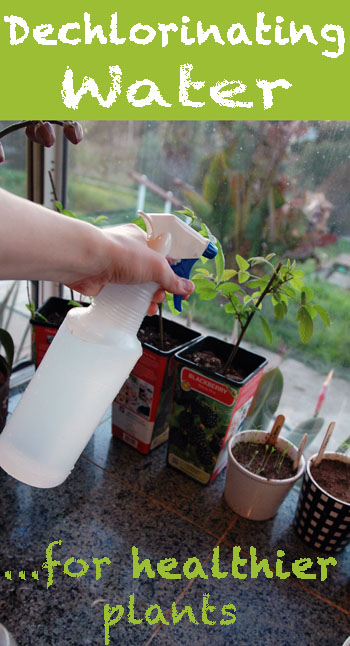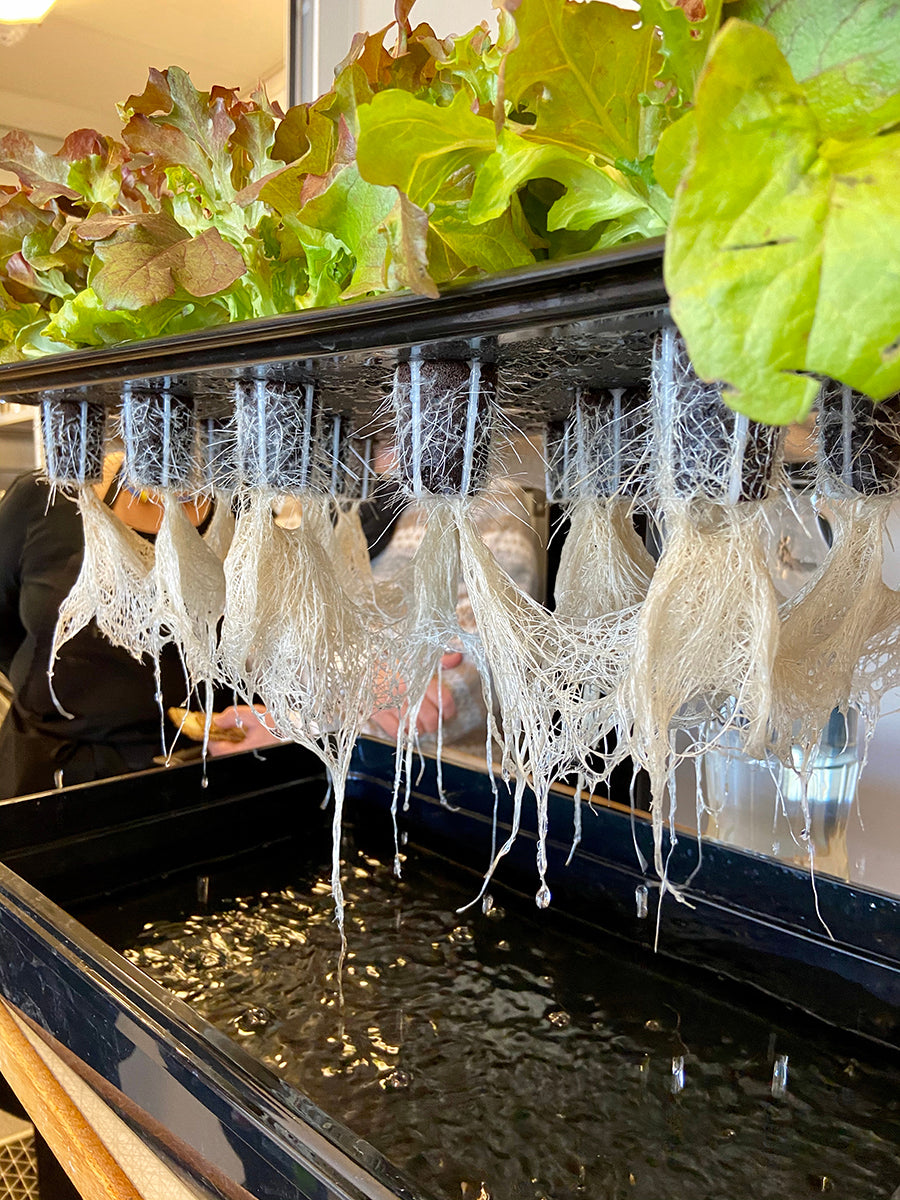To dechlorinate tap water for plants, use a water dechlorinator or let the water sit for 24 hours before watering. Tap water often contains chlorine, which can be harmful to plants.
Dechlorinating the water is important for the health of your plants. There are two simple methods to dechlorinate tap water. The first method is to use a water dechlorinator, which can be found at garden supply stores. Follow the instructions on the dechlorinator to treat the water before using it on your plants.
The second method is to let the water sit in an open container for 24 hours. During this time, the chlorine in the water will naturally dissipate. It is recommended to avoid using hot water, as it can increase the chlorine content. Taking these steps will ensure that your plants receive chlorine-free water, promoting their growth and overall well-being.

Credit: somedayilllearn.com
Why Dechlorinating Tap Water Is Important For Plants
Chlorine in tap water is harmful to plants, and dechlorinating it is crucial for their health. Chlorine can stunt plant growth and damage delicate roots. Dechlorination helps remove this harmful chemical and promotes thriving plants. Chlorine can also disrupt the balance of beneficial bacteria in the soil and affect nutrient absorption.
By dechlorinating tap water, you create a suitable environment for plants to grow and thrive. Using dechlorinated water ensures that plants receive the necessary moisture without the risk of chlorine-related damage. It is essential to consider dechlorination as part of your plant care routine and prioritize the health and well-being of your plants.
Give them the best chance to flourish by providing them with dechlorinated tap water.
Methods For Dechlorinating Tap Water
Dechlorinating tap water for plants can be done through various methods. One way is by using a dechlorination agent, which neutralizes the chlorine present in the water. Another method involves letting the water sit overnight, allowing the chlorine to dissipate naturally.
Alternatively, boiling the water can also remove the chlorine effectively. These techniques ensure that the tap water is safe for plants, as chlorine can be harmful to their growth. By following these methods, gardeners can provide their plants with chlorine-free water, promoting healthier and happier greenery.
So, next time you water your plants, consider dechlorinating your tap water using one of these simple and effective techniques. Your plants will thank you for it!
How to Dechlorinate Tap Water for Plants: Step by Step Guide
Choosing The Right Dechlorination Agent
When choosing a dechlorination agent for your plants, there are a few factors to consider. Firstly, think about the type of agent that suits your needs. Some popular dechlorination agents for plants include activated carbon and sodium bisulfite. Additionally, consider the effectiveness and safety of the agent.
Look for products that specifically state they are suitable for plant use and follow the instructions carefully. Once you have selected the right dechlorination agent, the steps to dechlorinate tap water are relatively simple. Start by filling a container with tap water and add the dechlorination agent according to the instructions.
Allow the water to sit for a few hours to ensure the chlorine is fully removed before using it to water your plants. Remember, providing your plants with chlorine-free water is essential for their overall health and well-being. So, choose wisely and keep your plants happy!

Letting Tap Water Sit Overnight To Dechlorinate
Tap water often contains chlorine, which can be harmful to plants. Letting tap water sit overnight is a common method to dechlorinate it. This process allows the chlorine to evaporate, making the water safe for plants. The scientific explanation behind the dechlorination process lies in the chlorine’s volatility.
By leaving tap water exposed to air, the chlorine molecules convert into gas and escape. When letting tap water sit overnight, it is essential to follow the proper procedure. Simply fill a container with tap water and leave it uncovered for at least 24 hours.
Although this method is widely used, it has its benefits and drawbacks. On the positive side, it is a simple and cost-effective solution. However, it does require some planning ahead, and the process may not remove other chemicals or impurities present in the water.
Overall, letting tap water sit overnight is an effective technique for dechlorinating water, ensuring the health and well-being of your plants.
Boiling Tap Water To Remove Chlorine
Boiling tap water is an effective and straightforward method for removing chlorine before using it on plants. When water is heated, chlorine rapidly evaporates, leaving behind dechlorinated water. It’s a simple step-by-step process that anyone can follow. However, like any method, boiling tap water for dechlorination has its pros and cons.
On the positive side, boiling tap water is inexpensive, easily accessible, and doesn’t require any additional chemicals or equipment. Additionally, it eliminates chlorine quickly and effectively. On the downside, boiling tap water takes time and energy, and it may not remove other impurities or contaminants present in the water.
Despite these drawbacks, boiling tap water remains a popular dechlorination method among plant enthusiasts. So the next time you want to water your plants, consider boiling tap water to ensure they receive chlorine-free hydration.
Other Factors To Consider For Dechlorinating Tap Water
Testing the chlorine levels in tap water is essential before dechlorinating it for your plants. A high chlorine concentration can harm your plants’ growth. The ph levels of the water also play a crucial role. Ensure the ph is within the optimal range for your specific plants.
If tap water isn’t suitable, filtered water can be a good alternative. Avoid common phrases and instead, engage readers with diverse expressions. Keep your sentences concise and in active voice for better readability. Remember to make your writing unique and free from plagiarism.
Without a conclusion, provide valuable information that benefits the reader.
Best Practices For Dechlorinating Tap Water For Plants
Dechlorinating tap water for plants requires consistent monitoring of watering schedule and adjusting techniques based on plant type. Monitoring helps ensure that plants receive the right amount of water at regular intervals. To optimize plant health, it is crucial to balance the temperature of the water.
Different plants have different water temperature preferences, so understanding their needs is essential. Adjusting watering techniques based on plant type can prevent waterlogging or dehydration. By using the appropriate watering methods, such as trickle irrigation or misting, plants can thrive.
Additionally, using natural dechlorinating methods like letting tap water sit overnight or using dechlorinating agents can be beneficial. These strategies help plants receive chlorine-free water, promoting their overall growth and well-being. Remember to consider the specific requirements of your plants and incorporate these best practices to dechlorinate tap water effectively.

Frequently Asked Questions On How To Dechlorinate Tap Water For Plants
How Does Tap Water Affect Plants?
Tap water can contain chlorine and other chemicals that can be harmful to plants. The presence of chlorine can burn the leaves and roots, causing the plants to wilt or die. Dechlorinating tap water before using it on plants is crucial for their health and growth.
Why Is It Necessary To Dechlorinate Tap Water For Plants?
Dechlorinating tap water removes harmful chemicals like chlorine, which can have negative effects on plant health. By dechlorinating the water, you ensure that your plants receive clean, chemical-free water that promotes their growth and prevents any damage or wilting caused by chlorine.
What Are The Different Methods To Dechlorinate Tap Water?
There are several methods to dechlorinate tap water for plants. One common method is using water conditioners or dechlorination products specifically designed for this purpose. Another method is to let the water sit for 24 hours to allow the chlorine to evaporate.
Alternatively, you can use activated carbon filters or even boil the water to remove chlorine.
Conclusion
To ensure the health and vitality of your plants, dechlorinating tap water is crucial. By following the steps outlined in this blog post, you can easily eliminate the harmful effects of chlorine in your water supply. First, let the water sit for 24 hours to allow the chlorine to dissipate naturally.
Alternatively, you can use a dechlorinating agent to instantly neutralize the chlorine. Next, test the water to ensure that all traces of chlorine are gone. Lastly, invest in a water filtration system or consider rainwater harvesting as an alternative water source for your plants.
Remember, chlorine can damage the delicate balance of microorganisms in the soil and hinder plant growth, so it is essential to take proactive measures to safeguard your plants. With this knowledge, you can confidently provide your plants with the optimal conditions they need to flourish.

